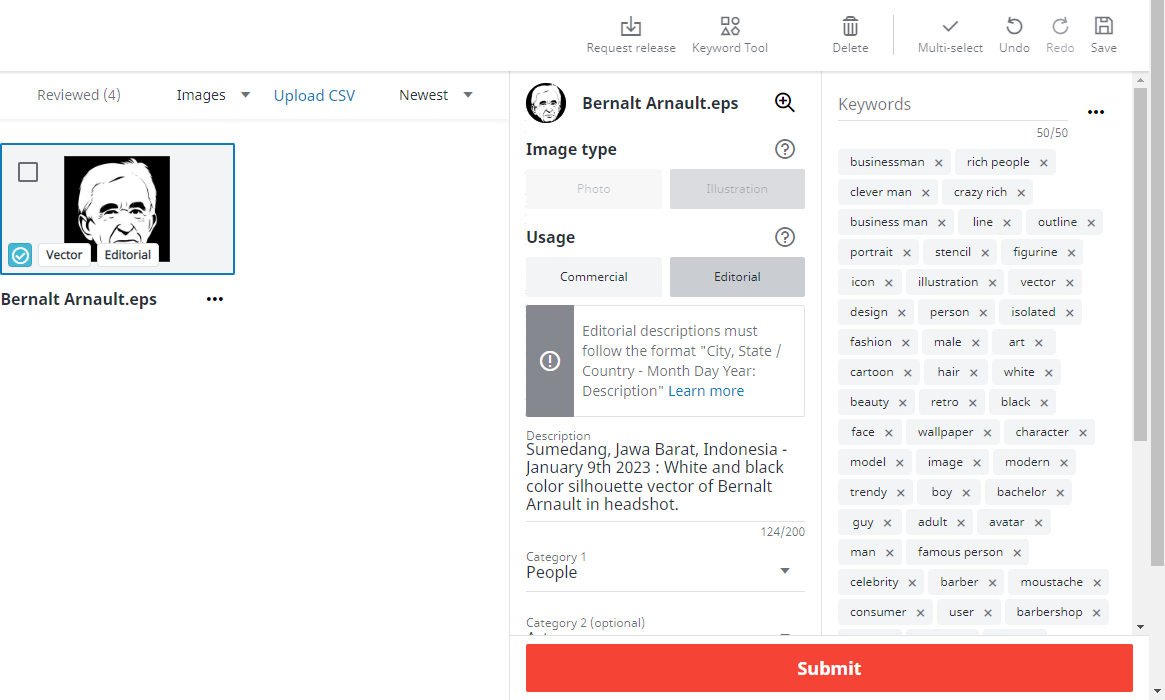If you’re a photographer or a content creator looking to monetize your images, Shutterstock is a fantastic platform to showcase your work. While many people focus on commercial images, editorial images are just as important—they tell stories, document events, and capture real-life moments. Submitting editorial images to Shutterstock can be a rewarding way to share your perspective with a global audience and earn royalties. In this guide, we’ll walk you through the essentials of submitting editorial images, from understanding what qualifies to the technical requirements you need to meet. Ready to get your images seen and appreciated? Let’s dive in!
Understanding Shutterstock’s Editorial Image Requirements
Before you hit that upload button, it’s crucial to understand what Shutterstock expects from editorial images. These images are used to illustrate news, events, or cultural topics, so they need to be accurate, relevant, and legally compliant. Here are some key aspects to keep in mind:
- Content Eligibility: Editorial images typically include newsworthy events, public figures (when in a news context), protests, sports, or cultural activities. Stock photos meant for commercial use usually don’t qualify.
- Model and Property Releases: Unlike commercial images, editorial content often doesn’t require model or property releases. However, you must have the legal rights to publish images of identifiable people or private property, especially if the image could be used out of context or in a negative light.
- Legal and Ethical Considerations: Avoid capturing images that invade privacy or depict sensitive situations without proper permission. Ensure your images do not infringe on copyrights or trademarks.
- Image Quality: Shutterstock insists on high-quality images. This means images should be in focus, well-lit, and free from noise or compression artifacts. Use a high-resolution camera, and aim for at least 4MP resolution for editorial images.
- Metadata and Descriptions: Accurate, detailed descriptions and keywords are vital. They help users find your images easily and ensure the content is properly contextualized.
Remember, editorial images are meant to inform and document real-world events, so authenticity and clarity are your top priorities. By understanding and adhering to these requirements, you’ll be on your way to successfully submitting images that meet Shutterstock’s standards and resonate with their audience.
Preparing Your Editorial Images for Submission
Before you jump into uploading your images, it’s super important to make sure they’re ready for submission. Shutterstock has specific guidelines for editorial images, and following these will help you get your work accepted faster and avoid unnecessary rejections.
First off, quality is king. Your images should be sharp, well-composed, and free of any distracting elements. Use a good camera and pay attention to lighting—natural light often works best for editorial content. Remember, editorial images are meant to tell a story, so clarity and relevance are key.
Next, consider the content itself. Since these are editorial images, they often depict newsworthy events, public figures, or scenes of social interest. Make sure your images are relevant, timely, and accurately represent the story or subject. Avoid overly staged or posed shots unless they are clearly marked as such.
Another critical aspect is legality. You must have the rights to all the content in your image. If your photo includes recognizable people, you need to have their consent (model release). If it features private property, you might need a property release. Shutterstock prefers images that are legally cleared, so include the necessary documentation if requested.
Additionally, edit your images for consistency and professionalism. Basic adjustments—like brightness, contrast, and cropping—are fine, but avoid over-editing. The goal is to present a true, authentic scene.
Finally, organize your images. Create a clear naming system that describes the content accurately, making it easier to locate and manage your submissions. Keep your files in high-resolution formats, such as JPEG or TIFF, and ensure they meet Shutterstock’s minimum size and quality standards.
In summary, preparing your editorial images involves quality control, relevance, legal clearance, proper editing, and organization. Taking these steps ensures your images are polished, compliant, and ready to make an impact on the Shutterstock platform.
Step-by-Step Guide to Uploading Editorial Images on Shutterstock
Ready to get your editorial images uploaded? Don’t worry—Shutterstock makes the process straightforward with a simple step-by-step approach. Let’s walk through it together so you can confidently submit your work.
- Log into Your Contributor Account: Head over to Shutterstock and sign in using your contributor credentials. If you haven’t registered yet, you’ll need to create an account first.
- Navigate to the Upload Section: Once logged in, click on the “Upload” button located at the top menu or in your dashboard. From there, select “Add Content” and choose “Editorial Images” as your submission type.
- Select Your Files: Click “Select Files” or drag and drop your images into the upload box. Make sure the files meet the recommended specifications—high resolution, appropriate format, and proper naming.
- Fill Out Metadata Details: For each image, you’ll be prompted to add relevant information. This includes:
- Title: A brief, descriptive headline.
- Description: A more detailed explanation of what’s depicted.
- Keywords: Tags that help users find your image, like “protest,” “cityscape,” or “public figures.”
- Select the License Type: Choose “Editorial” to specify the nature of your image. This informs Shutterstock that the image is for editorial use only and not for commercial purposes.
- Set the Release Information: If your image features recognizable people, landmarks, or private property, indicate whether you have the necessary releases. Upload any relevant documentation if applicable.
- Review Your Submission: Double-check all details, ensure your images are correctly tagged, and metadata is accurate. This step helps in faster approval and better visibility.
- Submit for Review: Once everything looks good, click the “Submit” button. Your images will then enter Shutterstock’s review process, which typically takes a few days.
And that’s it! After submission, keep an eye on your email and contributor dashboard for feedback or approval notifications. Remember, uploading quality editorial images and providing detailed metadata will increase your chances of acceptance and help your images reach a wider audience.
Tips for Increasing Your Acceptance Rate
Getting your editorial images accepted by Shutterstock can sometimes feel like a game of chance, but there are definitely strategies to boost your success rate. Here are some tried-and-true tips to help your submissions stand out and get approved more consistently.
Understand Shutterstock’s Editorial Guidelines
Before you even start submitting, make sure you’re familiar with Shutterstock’s specific requirements for editorial content. This includes respecting privacy rights, avoiding copyrighted material, and capturing images that are newsworthy, documentary, or current events-related. When in doubt, check their editorial guidelines page.
Focus on High-Quality, Clear Images
- Sharpness: Ensure your photos are in focus and well-exposed.
- Composition: Keep your framing clean and avoid clutter unless it adds context.
- Lighting: Use natural light or proper lighting setups to avoid shadows and poor exposure.
Clear, professional-looking images are more likely to be accepted and appreciated by buyers.
Capture Unique and Relevant Content
While current news or events are great, try to bring a fresh perspective. For example, instead of generic protest photos, focus on specific moments or emotional expressions. Unique angles and perspectives make your images stand out.
Use Accurate and Descriptive Titles, Descriptions, and Keywords
When uploading, craft detailed and precise metadata. Think about what a buyer might search for — use relevant keywords, specify the location, event, or subject. Clear descriptions help your image get discovered in searches.
Stay Updated with Trending Topics
Follow current news, social issues, and popular themes. Shutterstock often favors images that align with trending topics, so keeping your camera ready for these moments can increase your chances of acceptance.
In summary, approach your submissions with professionalism, attention to detail, and awareness of what Shutterstock looks for. Over time, as you refine your skills and understanding, your acceptance rate should improve, making the process more rewarding!
Common Mistakes to Avoid When Submitting Editorial Content
Even seasoned contributors can stumble if they’re not careful. Here are some common pitfalls to watch out for, so your editorial submissions don’t get rejected or delayed.
Ignoring Copyright and Privacy Laws
- Always get releases when required—especially if people are identifiable.
- Avoid copyrighted logos, trademarks, or branded products unless you have permission.
- Be cautious with private property — images featuring private areas may need a property release.
Failing to respect these rules can lead to rejection or even legal issues.
Submitting Poor-Quality Images
Blurry, poorly lit, or over-processed images don’t make the cut. Make sure your photos are high-resolution, well-composed, and free of noise or distractions. Remember, quality is king!
Using Irrelevant or Vague Metadata
When uploading, avoid generic titles like “Photo1” or vague descriptions. Instead, be specific and accurate. Misleading or incorrect keywords can cause your images to be rejected or not show up in relevant searches.
Uploading Non-Editorial Content
Since Shutterstock distinguishes between editorial and commercial images, double-check that your content fits the editorial category. Editorial images typically depict current events, news, or cultural moments. Using commercial-style images or staged setups can lead to rejection.
Over-Editing or Altering Images
While some minor adjustments are fine, overly manipulated images can be problematic, especially if they distort the reality of the scene. Keep edits natural and true to life.
Not Reviewing Submission Guidelines
Each platform has its own rules. Take the time to review Shutterstock’s editorial guidelines before submitting. This small step can save you from unnecessary rejections.
By avoiding these common mistakes, you’ll streamline your submission process and increase your chances of getting accepted. Remember, attention to detail and adherence to guidelines are your best friends in the world of stock photography!
Conclusion and Additional Resources for Shutterstock Contributors
Submitting editorial images to Shutterstock can be a rewarding way to share your unique perspectives and generate income from your photography. Remember, the key steps involve understanding Shutterstock’s guidelines, carefully selecting and editing your images, and submitting high-quality content that meets their standards. Consistency and attention to detail will increase your chances of acceptance and help you build a successful portfolio.
As you continue to contribute, take advantage of the many resources available to enhance your skills and stay informed:
- Shutterstock Contributor Dashboard: Your main hub for managing submissions, tracking earnings, and accessing tips.
- Help Center: Comprehensive guides on submission requirements, licensing, and copyright policies.
- Community Forums: Connect with other contributors to exchange advice, feedback, and inspiration.
- Photography Tutorials: Online courses and tutorials to improve your technical skills and creative eye.
Additionally, consider following Shutterstock’s official blog and social media channels for updates on market trends and best practices. Regularly reviewing successful contributor profiles can also provide valuable insights into what sells well and how to optimize your submissions. Staying informed and continuously honing your craft will help you maximize your potential as a Shutterstock contributor and ensure a smooth, fruitful experience in the editorial image marketplace.



